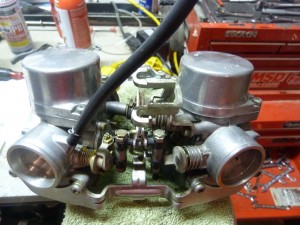Here’s the latest reader question, along with my reply!
Phil asks: I’ve been silently following the earlier back-and-forth about the pros (and cons) of keeping a motorcycle inside the house. Someone recently asked about draining the oil and other fluids – in addition to the gas in the tank. Can you give us your thoughts about that?
My reply: This isn’t scientific – it’s just what I’ve been doing for many years. If I am going to keep a bike inside longer than six months, I drain the oil . . . and refill the engine with fresh oil. I like to keep oil in the engine for several reasons, including (as regards my two-stroke bike) to keep the crank seals pliable. I always rotate the engine every so often – in order to circulate the oil and thereby keep critical surfaces such as cylinder walls always coated with a protective film of oil. 
Keep in mind, also, that most bikes have a wet sump transmission, meaning the clutch and gearbox share the same oil as the engine. You don’t want them to suffer premature and unnecessary wearing from just sitting.
This does mean keeping a battery around, to rotate the engine. It can also be done manually, by hand, if the bike has a kick starter – though not much oil pressure will be developed that way; still, better than nothing. If you decide to do as I do, either keep the battery out in the garage – if it’s a conventional lead-acid battery (these outgas and leak and so should never be kept in the living area). Better to get is AGM (dry) battery as these don’t leak our outgas; I also find they last much longer, if kept on a trickle charger (and even if not)
Back to the oil. The main issue here isn’t caustic fumes but messy leaks. I have a thick rubber pad (the kind you find at gyms) and park the bike on that. If the bike leaks a little, just wipe it up!
It’s also not a bad idea to remove the spark plugs once in a while – say every six months – and spritz the cylinders with WD-40 (especially if you are reluctant to use a battery to spin the engine).
Also: If the bike is carbureted be sure to drain the float bowls. Never leave a bike sitting for months with fuel in the carbs, leaving aside the smells . . . unless you like rebuilding carbs!
Coolant ought to be kept in mind, too – if the bike is water-cooled. If it was changed recently, no worries for a couple of years of storage. But keep track of it – as old coolant can lead to corrosion inside the water jackets and radiator, which can also get expensive.
. . .
Got a question about cars, bikes, or Sickness Psychosis? Click on the “ask Eric” link and send ’em in! Or email me at [email protected] if the @!** “ask Eric” button doesn’t work!
If you like what you’ve found here please consider supporting EPautos.
We depend on you to keep the wheels turning!
Our donate button is here.
If you prefer not to use PayPal, our mailing address is:
EPautos
721 Hummingbird Lane SE
Copper Hill, VA 24079
PS: Get an EPautos magnet or sticker or coaster in return for a $20 or more one-time donation or a $10 or more monthly recurring donation. (Please be sure to tell us you want a magnet or sticker or coaster – and also, provide an address, so we know where to mail the thing!)
My eBook about car buying (new and used) is also available for your favorite price – free! Click here. If that fails, email me at [email protected] and I will send you a copy directly!










sorry so late on this. if ya have a center stand use it, gets the weight off the tires. No center stand? Light bike: put it on a frame stand. heavy bike: pump up the tire pressure a good amount (don’t forget, put a sticker on the tank ‘check pressure’)
If your lucky and have non-ethanol fuel avail., use it. Bikes can sit 6 months easy with non-ethanol fuel in them, especially efi bikes (no air in the system).
No non-ethanol avail? star-tron additive is my go-to.
Man, there’s another example of the differences between bikes & small engines? The owners manual for an auger I have says to use the super expensive high octane premixed fuel, shut it off with fuel in the carb & store it that way.
I have a hard time doing that cause I was always told to drain the carb before storing anything.
Anyway, I’m trying to set up a d.i.y. battery backup sump pump (not the D/C kind, the real deal A/C with an inverter) & it was good to read about your all’s opinions about AGM batteries.
Eric,
You can also crank an engine without a kick start; you just have to take a socket and a t-wrench to the crank bolt. On my bike, this is accessed from the left side. However, if you have the spark plug in, that might be difficult to do, since you have to overcome the compression.
Also, having had experience with AGM batteries, boy do they hold a charge! There were times I let my old scooters sit for 2-3 months (with NO charger or battery tender, mind you), yet they started right up with their AGM batteries. They hadn’t lost any of their strength, either; they cranked over the engine as if they were freshly charged. I LOVE AGM batteries; they’re great!